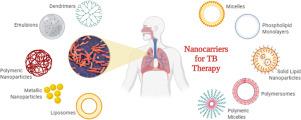Journal of Microbiological Methods ( IF 1.7 ) Pub Date : 2020-12-21 , DOI: 10.1016/j.mimet.2020.106127 Madushani H Dahanayake 1 , Anil C A Jayasundera 1

|
Regardless of advanced technology and innovation, infectious diseases continue to be one of the extreme health challenges in modern world. Tuberculosis (TB) is one of the top ten causes of deaths worldwide and the leading cause of death from a single infectious agent. The conventional TB drug therapy requires a long term treatment with frequent and multiple drug dosing with a stiff administration schedule, which results in low patient compliance. This eventually leads to the recurrence of the infection and the emergence of multiple drug resistance. Hence, there is an urgent need to develop more successful and effective strategies to overcome the problems of drug resistance, duration of treatment course and devotion to treatment. Nanotechnology has considerable potential for diagnosis, treatment and prevention of infectious diseases including TB. The main advantages of nanoparticles to be used as drug carriers are their small size, high stability, enhanced delivery of hydrophilic and hydrophobic drugs, intracellular delivery of macromolecules, targeted delivery of drugs to specific cells or tissues, and the feasibility of various drug administration routes. Moreover, these carriers are adapted to facilitate controlled, slow, and persistent drug release from the matrix. Above properties of nanoparticles permit the improvement of drug bioavailability and reduction of dosing frequency and may reduce the toxicity and resolve the problem of low adherence to the prescribed therapy. In this review, various types of nanocarriers have been evaluated as promising drug delivery systems for different administration routes and main research outcomes in this area have been discussed.
中文翻译:

用于结核病治疗的纳米药物递送优化:综述
尽管有先进的技术和创新,传染病仍然是现代世界面临的极端健康挑战之一。结核病 (TB) 是全球十大死因之一,也是单一传染性病原体导致死亡的主要原因。传统的结核病药物治疗需要长期治疗,频繁和多次给药,给药方案严格,导致患者依从性低。这最终导致感染的复发和多重耐药性的出现。因此,迫切需要开发更成功和有效的策略来克服耐药性、疗程持续时间和治疗投入等问题。纳米技术在包括结核病在内的传染病的诊断、治疗和预防方面具有相当大的潜力。纳米粒子作为药物载体的主要优点是其体积小、稳定性高、增强亲水性和疏水性药物的递送、大分子的细胞内递送、药物靶向递送至特定细胞或组织以及多种给药途径的可行性。 . 此外,这些载体适于促进从基质中受控、缓慢和持久的药物释放。纳米颗粒的上述特性可以提高药物生物利用度和减少给药频率,并可以降低毒性并解决对处方治疗依从性低的问题。在这篇综述中,各种类型的纳米载体已被评估为不同给药途径的有前途的药物递送系统,并讨论了该领域的主要研究成果。











































 京公网安备 11010802027423号
京公网安备 11010802027423号